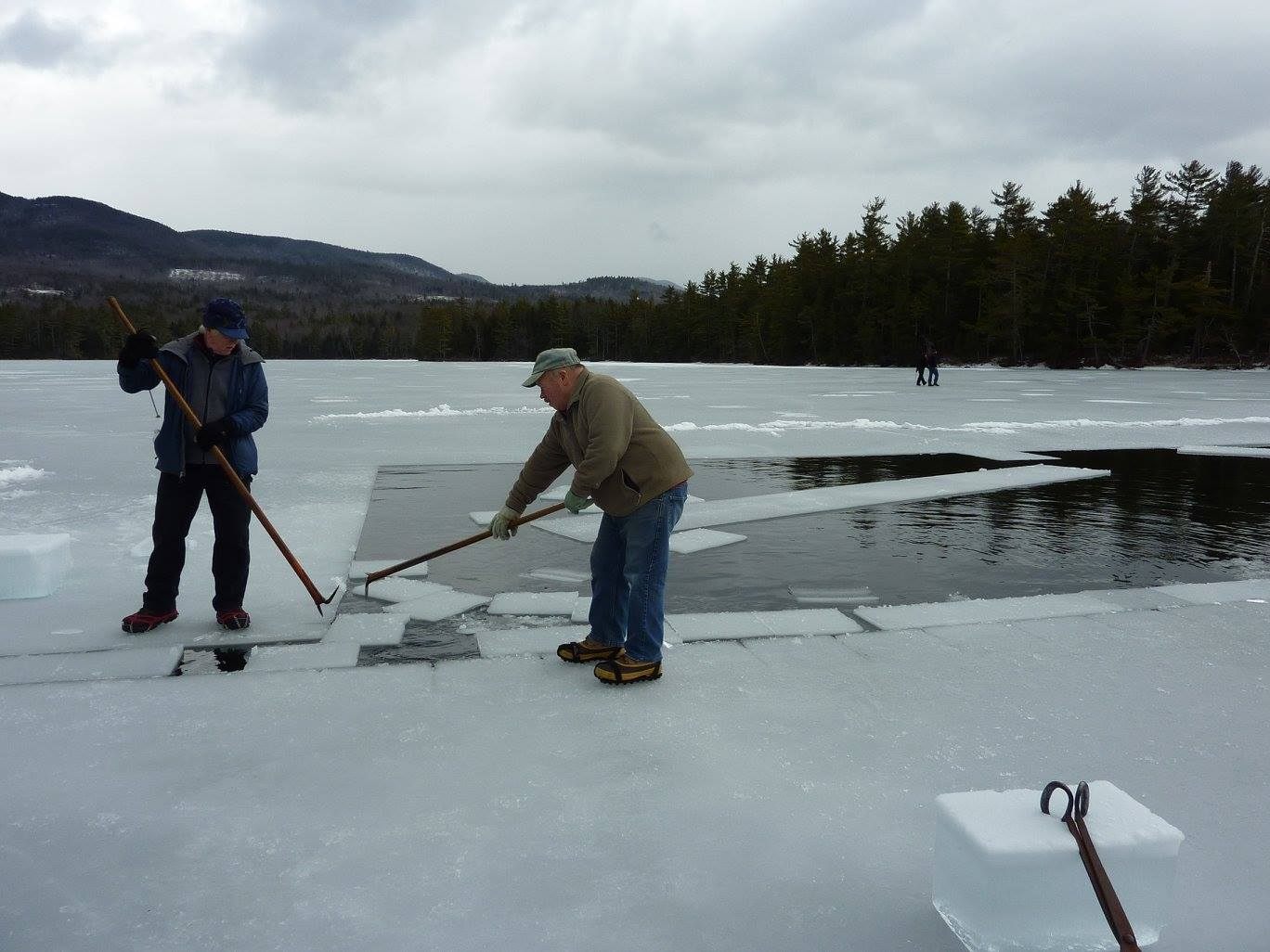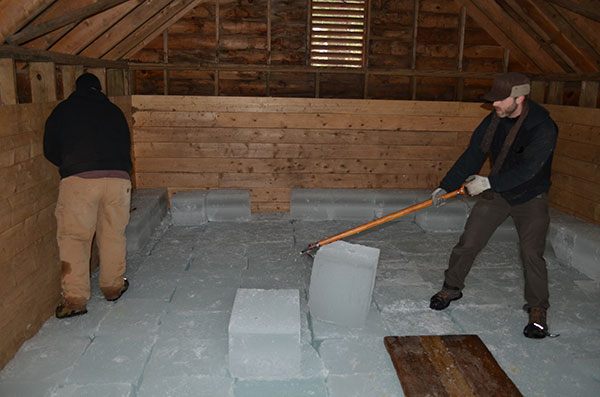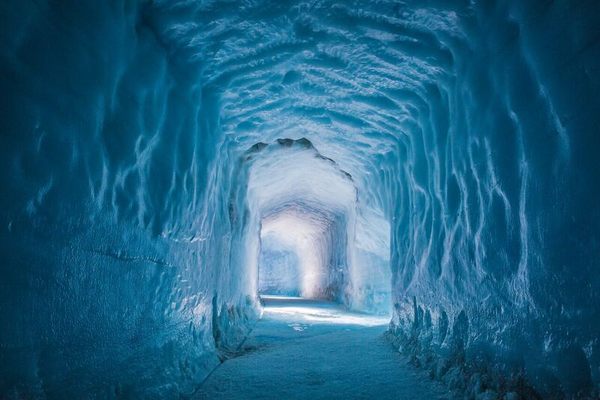The Pushers, Hookers and Sawyers Still Harvesting America’s Ice

Two pushers on Squam Lake during this year’s ice harvest. (All Photos: Eric Morse/Rockyhold Deephaven Camps)
In Holderness, New Hampshire, a small lakeside town right in the center of the state, January 26th dawned cold and clear. John Jurczynski woke up, tossed his electric drill into the passenger seat, and drove down to nearby Squam Lake, as he had every morning for weeks. He walked onto the ice, drilled a hole, and took a measurement. Later that day, he shot off a triumphant email: “Houston, we have 12 inches!”
Jurczynski is a manager at Rockywold Deephaven Camps, a rustic resort on the northwest corner of the lake. He is also, for a few days out of every winter, the head of an enthusiastic team of ice harvesters. Each year, about a dozen bundled-up residents arm themselves with picks and chainsaws, strap into crampons, and head out to the ice field to bring in a bumper crop, so that the camp can stock their iceboxes all summer.

2016’s first block gets lifted out of the grid.
Ice harvesting (or “icing,” as those in the know call it) combines mathematical precision, grace, and grit. After equipment setups and safety checks, one designated worker, called the “sawyer,” cuts a channel into the ice. Next, the sawyer scores the ice field, slicing it into a careful grid. A group of “pushers,” wielding long pikes, pry the cakes out of their rows and maneuver them to the channel.
The “hooker” then nabs a set of ice blocks and, together with the winch operator, pulls them up a handily placed ramp and into a truck. (Jurczynski, who has been overseeing the process since he signed on with the camp in 1990, tends to act as the hooker.) Once the truck is full, the blocks get carted to the ice house, where they’re gridded together again and layered with an insulating blanket of sawdust. Then they do it over and over again.
There aren’t many large-scale ice harvests left in the United States, and those that do still exist are more often historical curiosities than actual stockpiling attempts. But for a long, glittery swath of American history, the sight of workers herding huge ice cubes down freshly cut canals wasn’t particularly unusual. Commercial-scale ice harvesting dates back to the early 1800s, and the industry thrived until the 1940s—when the growing popularity of the electric refrigerator made hauling large chunks of ice essentially obsolete.
Rockywold Deephaven purposefully ignored that memo, says Jurczynski. The camp has used wild ice since it was founded in 1897, and sees very little reason to change their ways. Indeed, one of their chief aims is to stay frozen in time. “Families come for generations, and the grandparents like the place maintained similar to how it was when they were here,” says Jurczynski. “The cottages look essentially like they did about 70 years ago.” In 1967, camp management tried putting fridges in a few cabins, but, he says, the guests rebelled. “They requested ice boxes,” he says.

A side view of the ramp-and-truck operation.
To learn about the craft, aspiring pushers, hookers and sawyers can get ahold of Rockywold-Deephaven’s regularly updated Icing Operation Instruction and Safety Manual, which is both poetic and frank about the dangers involved. Personnel must “work on slippery surfaces with various cutting tools,” it reads, transporting objects “which are as hard as granite, and yet can slide easily and unexpectedly.” Each individual ice block is about the size of a milk crate, and can weigh up to 150 pounds.
But most education comes from older locals, who learned techniques from their parents and grandparents and have passed them down to younger generations. Norman Lyford, who mentored Jurczynski, retired from active participation last year after 70 straight harvests.

The camp has two icehouses, which it packs every year.
It can be hard to source parts for the ice boxes themselves (since no one makes them any more) but in recent years, Jurczynski has faced a more worrisome shortage. The camp’s primary ice field, which froze thickly and reliably for centuries, has been looking a bit thinner lately. Fifteen years ago, during another warm winter, Deep End wasn’t thick enough to hold up all the people and equipment necessary for the harvest, Jurczynski says.
He quickly scouted out a new spot, the nearby Squaw Cove, which is more isolated from the sun and wind and has since become their fallback. After what Jurczynski calls the “awkwardness” of recent weather, they fell back on Squaw Cove again this year.
The field came through, yielding three straight days of old-fashioned work, a renewed “connection between the camps and the natural environment,” and chunk after chunk of the cold stuff, sure to keep the guests refreshed through tourist season. “It’s exciting for me, but it’s also a relief when we have it in,” Jurczynski says. “I would hate to be in charge the year we didn’t have ice from the lake.”









Follow us on Twitter to get the latest on the world's hidden wonders.
Like us on Facebook to get the latest on the world's hidden wonders.
Follow us on Twitter Like us on Facebook